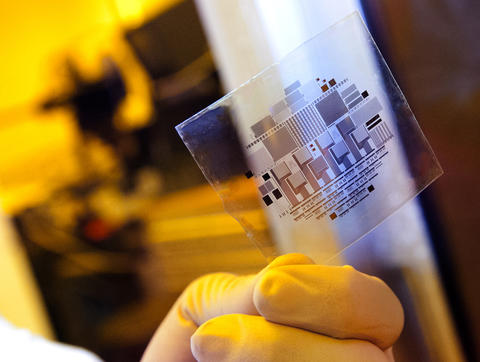
A circuit made from organic thin-film transistors is fabricated on a flexible plastic substrate. A team of NIST, Wake Forest and Penn State University researchers has identified an overlooked source of electrical resistance that can exert a dominant influence on organic-semiconductor performance.
It's hardly a character flaw, but organic transistors—the kind envisioned for a host of flexible electronics devices—behave less than ideally, or at least not up to the standards set by their rigid, predictable silicon counterparts. When unrecognized, a new study finds, this disparity can lead to gross overestimates of charge-carrier mobility, a property key to the performance of electronic devices.
If measurements fail to account for these divergent behaviors in so-called "organic field-effect transistors" (OFETs), the resulting estimates of how fast electrons or other charge carriers travel in the devices may be more than 10 times too high, report researchers from the National Institute of Standards and Technology (NIST), Wake Forest University and Penn State University. The team's measurements implicate an overlooked source of electrical resistance as the root of inaccuracies that can inflate estimates of organic semiconductor performance.
Their article appears in the latest issue of Nature Communications.
Already used in light-emitting diodes, or LEDs, electrically conductive polymers and small molecules are being groomed for applications in flexible displays, flat-panel TVs, sensors, "smart" textiles, solar cells and "Internet of Things" applications. Besides flexibility, a key selling point is that the organic devices—sometimes called "plastic electronics"—can be manufactured in large volumes and far more inexpensively than today's ubiquitous silicon-based devices.
A key sticking point, however, is the challenge of achieving the high levels of charge-carrier mobility that these applications require. In the semiconductor arena, the general rule is that higher mobility is always better, enabling faster, more responsive devices. So chemists have set out to hurry electrons along. Working from a large palette of organic materials, they have been searching for chemicals—alone or in combination—that will up the speed limit in their experimental devices.
Just as for silicon semiconductors, assessments of performance require measurements of current and voltage. In the basic transistor design, a source electrode injects charge into the transistor channel leading to a drain electrode. In between sits a gate electrode that regulates the current in the channel by applying voltage, functioning much like a valve.
Typically, measurements are analyzed according to a longstanding theory for silicon field-effect transistors. Plug in the current and voltage values and the theory can be used to predict properties that determine how well the transistor will perform in a circuit.
Results are rendered as a series of "transfer curves." Of particular interest in the new study are curves showing how the drain current changes in response to a change in the gate electrode voltage. For devices with ideal behavior, this relationship provides a good measure of how fast charge carriers move through the channel to the drain.
"Organic semiconductors are more prone to non-ideal behavior because the relatively weak intermolecular interactions that make them attractive for low-temperature processing also limit the ability to engineer efficient contacts as one would for state-of-the-art silicon devices," says electrical engineer David Gundlach, who leads NIST's Thin Film Electronics Project. "Since there are so many different organic materials under investigation for electronics applications, we decided to step back and do a measurement check on the conventional wisdom."
Using what Gundlach describes as the semiconductor industry's "workhorse" measurement methods, the team scrutinized an OFET made of single-crystal rubrene, an organic semiconductor with a molecule shaped a bit like a microscale insect. Their measurements revealed that electrical resistance at the source electrode—the contact point where current is injected into the OFET— significantly influences the subsequent flow of electrons in the transistor channel, and hence the mobility.
In effect, contact resistance at the source electrode creates the equivalent of a second valve that controls the entry of current into the transistor channel. Unaccounted for in the standard theory, this valve can overwhelm the gate—the de facto regulator between the source and drain in a silicon semiconductor transistor—and become the dominant influence on transistor behavior.
At low gate voltages, this contact resistance at the source can overwhelm device operation. Consequently, model-based estimates of charge-carrier mobility in organic semiconductors may be more than 10 times higher than the actual value, the research team reports.
Hardly ideal behavior, but the aim of the study, the researchers write, is to improve "understanding of the source of the non-ideal behavior and its impact on extracted figures of merit," especially charge-carrier mobility. This knowledge, they add, can inform efforts to develop accurate, comprehensive measurement methods for benchmarking organic semiconductor performance, as well as guide efforts to optimize contact interfaces.
E. G. Bittle, J. I. Basham, T. N. Jackson, O. D. Jurchescu, and D. J. Gundlach, "Mobility overestimation due to gated contacts in organic field-effect transistors," Nature Communications 7, Article number: 10908, March 10, 2016; http://dx.doi.org/10.1038/ncomms10908

